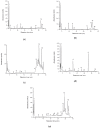Bioactive Compounds and Volatile Profiles of Five Transylvanian Wild Edible Mushrooms
- PMID: 30544917
- PMCID: PMC6321188
- DOI: 10.3390/molecules23123272
Bioactive Compounds and Volatile Profiles of Five Transylvanian Wild Edible Mushrooms
Abstract
This study aimed to determine the chemical composition, fatty acids, volatile profile and phenolic compounds profiles from five wild edible mushrooms (Agaricus bisporus, Pleurotus ostreatus, Cantharellus cibarius, Boletus edulis, Lactarius piperatus) from Romania. The results indicated that the dried fruiting bodies of selected mushrooms were rich in proteins (36.24 g/100 g dw-Boletus edulis) and carbohydrates (62.45 g/100 g dw-Lactarius piperatus). 4-Hydroxybenzoic acid and cinnamic acid, were the main phenolic compound present in all selected species. Additionally, the fatty acid pattern included polyunsaturated acids in more than 60% of all fatty acids followed by monounsaturated fatty acids (30%). For the studied mushroom samples, the main volatile compounds identified by the gas chromatography-mass spectrometry were hexanal, benzaldehyde and dodecanoic acid. According to the obtained results, the fruiting bodies of selected Romanian mushrooms are a rich source of bioactive molecules indicating that they may be further exploited as functional ingredients in the composition of innovative food products.
Keywords: chemical compounds; fatty acid; mushrooms; phenolic compounds; volatile profile.
Conflict of interest statement
The authors declare no conflict of interest.
Figures



References
MeSH terms
Substances
Grants and funding
LinkOut - more resources
Full Text Sources

